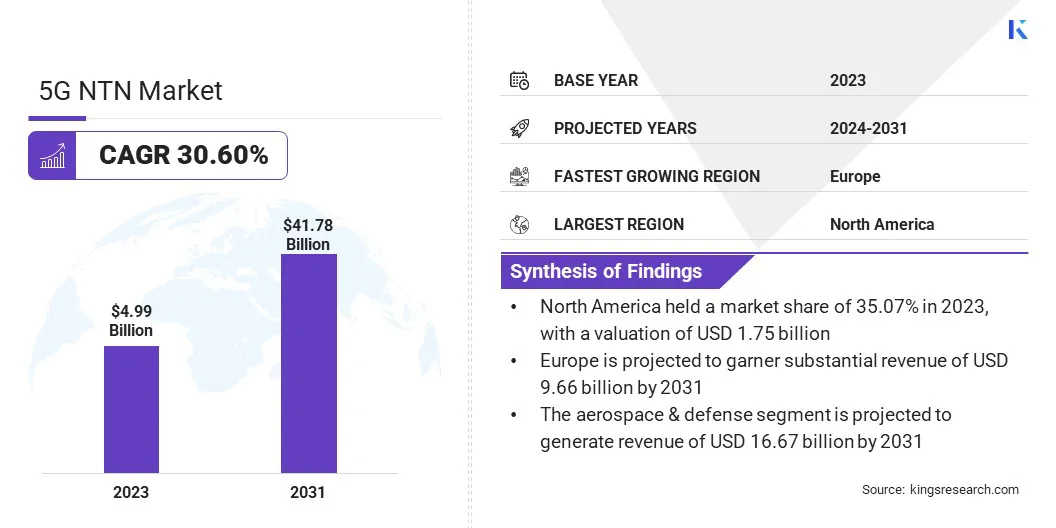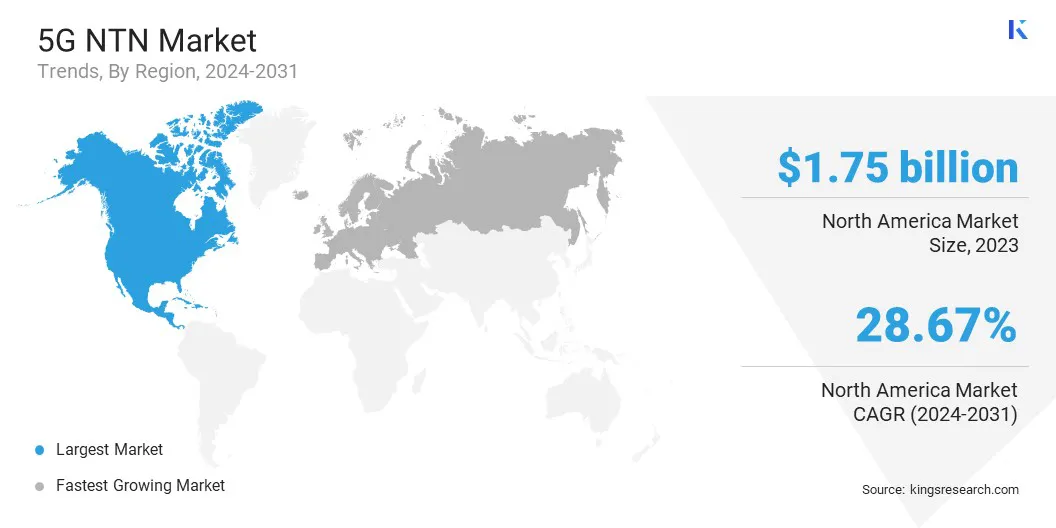5G NTN Market Size
The global 5G NTN Market size was valued at USD 4.99 billion in 2023 and is projected to reach USD 41.78 billion by 2031, growing at a CAGR of 30.60% from 2024 to 2031. In the scope of work, the report includes solutions offered by companies such as SES S.A., EchoStar Corporation, AST & Science, LLC, oneweb.net., Rohde & Schwarz, Gatehouse Satcom A/S, Omnispace, LLC, Thales, Skylo, Keysight Technologies and Others.
The market is witnessing a paradigm shift in connectivity solutions, offering unparalleled opportunities for end use industries. The emergence of 5G NTN signifies a pivotal advancement in connectivity solutions, offering unprecedented access to previously unreachable areas. Industries, ranging from agriculture to healthcare, are witnessing profound shifts in operational methodologies, facilitated by real-time monitoring, automation, and collaborative capabilities enabled by 5G NTN.
This technology is projected to offer a new perspective of connectivity, characterized by its ability to provide robust and reliable communication infrastructure, thereby driving demand across diverse industries.
Furthermore, the impact of 5G NTN is expanding beyond industrial applications, spanning various media platforms, augmented reality (AR), and virtual reality (VR) applications. With its low latency and high throughput capabilities, 5G NTN is poised to revolutionize consumer interactions by enabling seamless experiences on mobile devices, smart gadgets, and other communication systems.
The increasing consumer demand for faster and more dependable connectivity is propelling the adoption of 5G NTN-enabled devices and services. As network operators continue to invest in expanding coverage and fortifying network infrastructure, the 5G NTN market is anticipated to experience notable growth, thereby fostering innovation and stimulating economic development on a global scale.
The global 5G NTN market is a burgeoning sector within the telecommunications industry dedicated to the deployment and utilization of 5G networks using non-traditional infrastructure such as satellites, high-altitude platforms (HAPs), and drones. This market encompasses a wide range of technologies and services aimed at extending connectivity to remote, underserved, and challenging environments where traditional terrestrial networks may be impractical or unavailable.
With its emphasis on low latency, high throughput, and resilience, the market is poised to revolutionize communication and connectivity solutions across various industries, thereby driving innovation, economic growth, and societal advancement worldwide.

Analyst’s Review
Key players in the 5G NTN market are actively focusing on several key aspects to maintain their competitive edge. There is a strong emphasis on technological innovation, with companies investing heavily in R&D to develop advanced satellite constellations, high-altitude platforms, and drone-based solutions for 5G connectivity.
These technologies enable key players to expand coverage, increase bandwidth, and reduce latency, catering to the evolving needs of both consumers and industries. Additionally, strategic partnerships and collaborations are being forged to leverage complementary strengths and resources, thereby facilitating the development and deployment of integrated 5G NTN solutions.
- key players are estimated to continue investing in cutting-edge technologies, exploring new business models, and adopting emerging trends, such as space-based internet services and autonomous network management, to shape the outlook of the market.
5G NTN Market Growth Factors
The global 5G NTN market is experiencing substantial growth driven by rising demand for universal connectivity. This is fueled by the increasing reliance on data-driven applications and the need for seamless communication across diverse geographical locations. This growing demand is emphasizing the necessity for advanced solutions such as 5G NTN to effectively meet evolving connectivity requirements.
Moreover, advancements in satellite technology, such as low-earth orbit (LEO) constellations and high throughput satellites (HTS), are revolutionizing the capabilities of 5G NTN networks. These developments have enabled faster data transmission and lower latency, enhancing the overall performance and reliability of non-terrestrial networks.
Additionally, the growth of high-altitude platforms (HAPs), including tethered drones and balloons, presents a cost-effective solution for extending coverage in remote areas, which supports traditional satellite networks and addresses connectivity gaps. However, high initial investment costs pose a significant barrier to the widespread deployment of 5G NTN infrastructure, especially in the case of HAP networks.
The substantial upfront capital required for deployment and maintenance is hindering companies from investing in non-terrestrial solutions. Furthermore, regulatory hurdles, particularly concerning spectrum allocation and HAP operations, vary across regions, thus complicating the seamless deployment of 5G NTN networks.
Addressing these challenges is crucial for ensuring its successful integration into global communication ecosystems. Despite the obstacles, the market for 5G NTN is anticipated to witness robust growth in the forthcoming years, driven by the increasing demand for reliable and high-speed connectivity worldwide.
5G NTN Market Trends
The notable shift toward hybrid networks, integrating 5G NTN with terrestrial infrastructure to optimize network performance and cost-efficiency, is supporting market growth. This trend reflects the recognition of the complementary strengths of both terrestrial and non-terrestrial networks, allowing for seamless connectivity across diverse environments.
Moreover, evolving business models are emerging to meet the diverse needs of users and applications. Subscription-based pricing models and pay-as-you-go options are gaining significant traction, offering flexibility and scalability to both consumers and businesses.
Additionally, strategic partnerships are becoming increasingly crucial in fostering the growth of the market. Collaborations between satellite operators, mobile network operators, and service providers facilitate synergies and innovation, thereby enabling the development of comprehensive solutions and expanding market reach. By adopting these trends, stakeholders aim to navigate the dynamic landscape of the 5G NTN market effectively and capitalize on emerging opportunities for growth.
Segmentation Analysis
The global market is segmented based on component, application, location, end use, and geography.
By Component
Based on component, the 5G NTN market is categorized into hardware, software, and services. The hardware segment generated the highest revenue of USD 3.43 billion in 2023. The proliferation of advanced hardware components such as antennas, modems, and transceivers for establishing robust 5G NTN infrastructure is mainly driving segment growth.
Moreover, the continuous advancements in hardware technology, including miniaturization of components and power efficiency improvements, are propelling the adoption of 5G NTN solutions across various industries.
Additionally, the growing demand for specialized hardware tailored to the unique requirements of non-terrestrial networks is fueling the segment's dominance. Hardware components play a pivotal role in enabling seamless connectivity and facilitating transformative applications, thus contributing to the growth of the segment.
By Location
Based on location, the market is divided into urban, rural, remote, and isolated. The remote segment garnered the largest 5G NTN market share of 55.89% in 2023. Remote areas, with their limited terrestrial infrastructure and challenging geographical terrain, often face connectivity gaps that traditional networks find difficult to address.
As a result, the demand for 5G NTN solutions is prominent in remote regions, where non-terrestrial networks offer a viable means of extending connectivity and bridging the digital divide. Moreover, the growing adoption of high-altitude platforms and satellite-based solutions has significantly enhanced the feasibility and efficacy of providing connectivity in remote areas, thereby bolstering the dominance of the remote segment in the market.
By End Use
Based on end use, the market is classified into maritime, aerospace & defense, government, mining, and others. The aerospace & defense segment is projected to generate revenue of USD 16.67 billion by 2031.
The aerospace & defense sector demands resilient and secure communication solutions to support mission-critical operations, including surveillance, reconnaissance, and tactical communication. 5G NTN offers a compelling value proposition, providing high-speed, low-latency connectivity even in remote and hostile environments.
Moreover, the integration of 5G NTN into defense systems enhances both situational awareness and operational efficiency, thereby driving its adoption within the aerospace & defense sector. Additionally, the burgeoning commercial aerospace sector, coupled with the growing demand for satellite-based communication services, is further augmenting product uptake across the aerospace & defense end-use segment in the coming years.
5G NTN Market Regional Analysis
Based on region, the global market is classified into North America, Europe, Asia-Pacific, MEA, and Latin America.

The North America 5G NTN market share stood around 35.07% in 2023 in the global market, with a valuation of USD 1.75 billion. The dominance in the region is driven by strategic partnerships, regulatory support, advanced aerospace infrastructure, strong demand for rural connectivity, and competitive dynamics.
- Collaborations between telecom giants and satellite operators, facilitated by favorable regulatory frameworks and spectrum allocation, boost the integration of satellite-based connectivity into 5G networks.
The region's leading aerospace and technology companies leverage their expertise to develop innovative solutions, such as satellite constellations and high-altitude platforms, to meet the growing demand for reliable connectivity in remote areas and IoT applications. Intense competition among market players drives continuous innovation and investment in 5G NTN technology, thereby solidifying North America's position as a hub for non-terrestrial connectivity solutions.
Europe is projected to garner substantial revenue of USD 9.66 billion by 2031. This growth is mainly driven by the convergence of 5G NTN technology with multi-access edge computing (MEC) infrastructure in the region. This integration allows European operators to deliver innovative services such as augmented reality (AR), virtual reality (VR), and autonomous vehicles with low-latency and high-bandwidth capabilities.
Moreover, Europe's focus on extending high-speed connectivity to rural and underserved areas aligns with the scalability and cost-effectiveness of 5G NTN networks. Government subsidies, grants, and regulatory support further incentivize deployment, thereby fostering digital inclusion and economic development.
Additionally, the region's robust aerospace and satellite sector, coupled with public-private partnerships, is boosting the development of cutting-edge technologies, thus fueling regional market growth.
Competitive Landscape
The 5G NTN market report will provide valuable insight with an emphasis on the fragmented nature of the industry. Prominent players are focusing on several key business strategies such as partnerships, mergers and acquisitions, product innovations, and joint ventures to expand their product portfolio and increase their market shares across different regions.
Manufacturers are adopting a range of strategic initiatives, including investments in R&D activities, the establishment of new manufacturing facilities, and supply chain optimization, to strengthen their market standing.
List of Key Companies in 5G NTN Market
- SES S.A.
- EchoStar Corporation
- AST & Science, LLC
- oneweb.net.
- Rohde & Schwarz
- Gatehouse Satcom A/S
- Omnispace, LLC
- Thales
- Skylo
- Keysight Technologies
Key Industry Developments
March 2024 (Collaboration) - Omnispace, unveiled a new collaboration with MTN, Africa's leading mobile network provider. With a customer base exceeding 290 million across 19 nations, MTN offers a diverse range of services, including voice, data, fintech, digital solutions, enterprise offerings, wholesale services, and API services. This joint venture aims to investigate the utilization of the S-band for satellite services, with the goal of broadening MTN's array of wireless services available in their respective markets.
The Global 5G NTN Market is Segmented as:
By Component
- Hardware
- Software
- Services
By Application
By Location
- Urban
- Rural
- Remote
- Isolated
By End Use
- Maritime
- Aerospace & Defense
- Government
- Mining
- Others
By Region
- North America
- Europe
- France
- U.K.
- Spain
- Germany
- Italy
- Russia
- Rest of Europe
- Asia-Pacific
- China
- Japan
- India
- South Korea
- Rest of Asia-Pacific
- Middle East & Africa
- GCC
- North Africa
- South Africa
- Rest of Middle East & Africa
- Latin America
- Brazil
- Argentina
- Rest of Latin America


